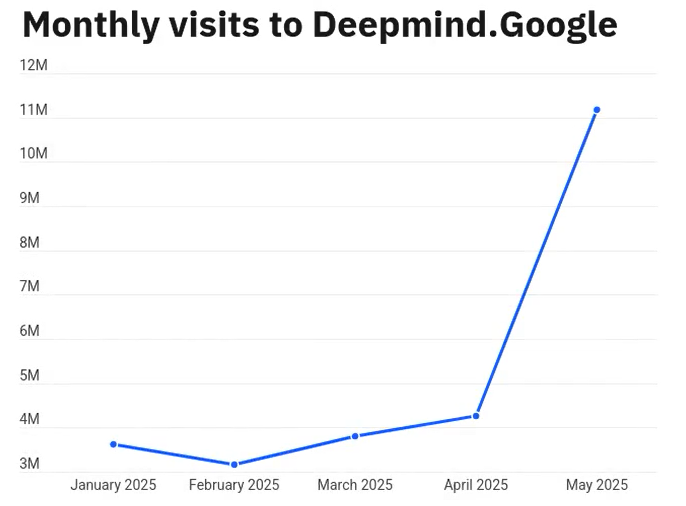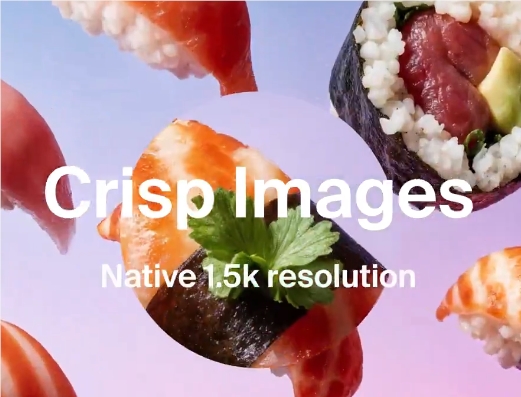In recent years, multi-modal AI technology has gradually become the growth engine of the tech industry with its powerful cross-domain capabilities. Google DeepMind's newly released Veo3 model and OpenAI's GPT-4o, which combine text, images, videos, and even audio generation capabilities, have not only enhanced user experience but also attracted widespread global attention and traffic surges. Below, AIbase will help you sort out the latest information from the web and delve into how multi-modal AI is driving dual breakthroughs in technology and business.
DeepMind Veo3: A New Benchmark for Video Generation, Traffic Increased by 162%
The Veo3 model unveiled by Google DeepMind at the 2025 I/O Conference is considered a milestone in the field of AI video generation. According to network data, after the I/O Conference, DeepMind's traffic surged by 162%, with more than 50% of this growth driven by Veo3. Veo3 can generate high-quality videos based on text and image prompts and, for the first time, synchronously generate audio content, including dialogue, sound effects, and ambient sounds. For example, a video showing an old sailor facing the sea, accompanied by the sound of waves and dialogue, demonstrated stunning realism.
In addition, Veo3 excels in physical realism, lip synchronization, and video coherence, almost eliminating the "flaws" commonly found in traditional AI-generated content. Behind this, Google DeepMind collaborated with the creative industry to ensure the balance between safety and practicality of the model. For instance, each frame generated by Veo3 embeds SynthID watermarking technology to distinguish AI-generated content and reduce the risk of misinformation spreading.

GPT-4o: The Image Magic Ignites User Enthusiasm
At the same time, OpenAI's GPT-4o, with its powerful multi-modal capabilities, especially image generation and processing functions, quickly caught the world's attention. On the web, GPT-4o is praised as the "image magician," with its high-quality image and video content leaving users in awe. From quickly generating realistic portraits to creating dynamic scenes based on complex prompts, the adoption speed of GPT-4o is remarkable. Consumers rave about its "plug-and-play" experience, calling it the "benchmark of multi-modal AI."
This intuitive interaction experience is precisely the key to the rapid popularity of GPT-4o. Users without complex technical backgrounds can obtain high-quality multi-modal outputs by simply inputting natural language prompts. This "it just works" characteristic has greatly promoted its widespread application in social media and content creation fields.
Multi-modal AI: Transformation from Function to Growth Engine
The rise of multi-modal AI is not just a technological advancement but also a business model innovation. Whether it's DeepMind's Veo3 or OpenAI's GPT-4o, these models attract consumer and corporate attention by providing immersive, cross-sensory experiences. Network comments point out that the intuitiveness and efficiency of multi-modal AI have brought unprecedented convenience to content creation, education, marketing, and other fields. For example, financial technology company Klarna significantly shortened the production cycle from ad materials to YouTube shorts by using Veo3 and Imagen models.
However, the rapid development of multi-modal AI also brings challenges. Discussions on the lifelike videos generated by Veo3 are heated online, with some lamenting "the line between reality and AI is blurred," while others worry about the potential misuse of deepfake technology. To address this, Google DeepMind emphasized the role of SynthID watermarking and security filters to ensure transparency and safety of content.
Futuristic Outlook: The Infinite Potential of Multi-modal AI
From DeepMind's Veo3 to OpenAI's GPT-4o, multi-modal AI is reshaping the future of content creation. Whether it's generating captivating short videos or providing efficient marketing tools for businesses, these technologies are integrating into daily life at an astonishing pace. AIbase believes that as multi-modal AI continues to improve, its application potential in education, entertainment, healthcare, and other fields will continue to be unleashed, becoming the core engine driving technological and societal progress.






